|
Current Affairs
The Pilkhana Probe
More Questions Than Answers
Syed Zain Al Mahmood
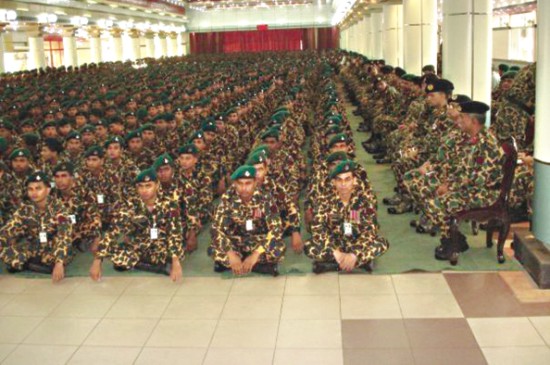
On May the 27th, exactly three months after the massacre at the Pilkhana BDR Headquarters, the government inquiry report finally saw the light of day. The 12-member probe committee, chaired by former Additional Secretary Anisuzzaman Khan had been tasked with unearthing the cause of the BDR mutiny on February 25 and 26, investigating related matters and making recommendations for prevention of similar incidents in the future.
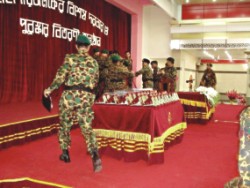 |
The mutiny starts. |
The committee formed by the government in the aftermath of the Pilkhana carnage got off to an inauspicious start when it was revealed that the home minister would be heading the probe body. Following criticism, the committee was reconstituted on March 2 with the former civil servant at the helm. It was given 7 days to complete the investigation. When the deadline was about to expire on March 9, the committee asked for another week, then another 4 days. Finally, on March 30 it was granted 30 more workdays to complete the probe. That deadline expired on May 11.
The spotlight on the committee's work was further intensified when the minister in charge of coordinating the inquiry announced that militant links had been discovered. On March 12, commerce minister Faruq Khan announced to the world that some detained BDR Jawans had something to do with JMB. Then he suggested the involvement of “several militant organisations.” His comments were reported with due importance by the international media. The BBC's headline read “Militant link to Dhaka mutiny” (March 12). “Bangladesh's Minister Reiterates Militant's Link to BDR Mutiny” said Voice of America (March 16). Then the commerce minister backpedaled, saying that these were his “personal observations.”
 |
The report, running to 309 pages, failed to dig up the exact cause of the bloody revolt. |
In the end, the government probe report had more bark than bite. The report, running to 309 pages, failed to dig up the exact cause of the bloody revolt. “It can be said with certainty that real reasons and motives behind this brutal incident could not be clearly determined,” committee chief Anisuzzaman Khan told a crowded press conference at the Home Ministry. The committee did not find any political, militant or foreign links to the mutiny.
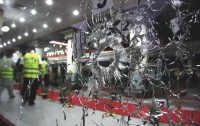 |
| The report praises the government and critises the intelligence services. |
The government naturally chose to dwell on the fact that it had made the report public, when so many probe reports in the past had been swept under the carpet. “This is historic,” said Home minister Sahara Khatun. “Previous governments have never made such reports public before. We gave our word that we would make public the findings of the probe committee and we have done it,” she noted.
But the 7-page summary that has been made public fails to shed light on many important issues. The report suggests that the mentality of not accepting army command, resentment over the “Daal-bhat programme” and dispute over pay and benefits formed the backdrop of the mutiny. At the same time the committee notes that such demands do not seem sufficient cause for such a bloodbath. The inquiry report duly praises the government but heavily criticises the intelligence services for their failure to provide advance warning. The report also lists as an auxiliary cause the “irresponsible media coverage” of the different demands of the mutineers by the electronic media and the information ministry's “overall lack of control” over the media.  Although Anisuzzaman's report gives the administration the benefit of every doubt, glaring questions remain. The committee found that the mutineers had met political leaders including MPs before and after the election regarding their demands. Failing to get a response from the political leaders, the mutineers decided to take the Director General of the BDR and other officers hostage. Although Anisuzzaman's report gives the administration the benefit of every doubt, glaring questions remain. The committee found that the mutineers had met political leaders including MPs before and after the election regarding their demands. Failing to get a response from the political leaders, the mutineers decided to take the Director General of the BDR and other officers hostage.
Soldiers in uniform breaking the chain of command and going to politicians with demands should in itself raise serious concerns. Did the political leadership fail to realize the gravity of the situation? Did they inform the relevant government ministries of possible unrest? The probe report does not address these questions.
The inquiry found that leaflets urging the Jawans to rise up had been printed and been in circulation for a few days prior to the mutiny. There are also indications that copies of the fliers fell into the hands of the National Security Intelligence (NSI) on February 23. It seems astounding that news of such a grave threat was not communicated to the highest levels of government, especially since the Prime Minister was going to the Pilkhana on February 24. The committee has not determined who was responsible for this, and at what level.
The government handling of the Pilkhana standoff has received praise and criticism in equal measure. Supporters say the government's decision to pursue a negotiated solution prevented a wider conflict. Detractors suggest rapid military action in the early hours of the 25th of February would have saved lives and that the delay actually allowed the mutineers to harden their stance and advance their demands through the media and in direct negotiations with the Prime Minister. The probe committee strongly defended the government's actions.
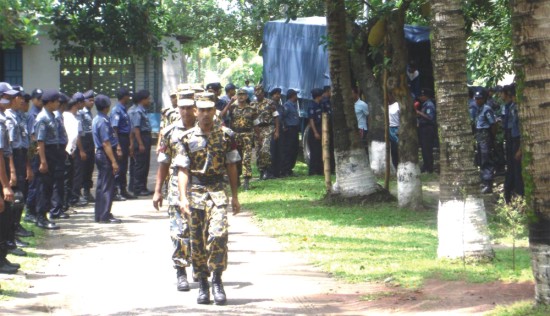 |
34 BDR soldiers in Kurigram being entered into Kurigram prison. |
In the standard hostage/barricade situation models followed by the FBI and other law enforcement and counter-terrorism agencies, the main objective is to preserve life. This includes the lives of hostages, civilians, personnel, and even the hostage takers themselves. In order to achieve a successful resolution it is vitally important to secure the perimeter, establish lines of communication with the hostage-takers and if possible the hostages, and make sure arms and ammunition do not make it out of the barricaded area. According to the FBI's classification, a hostage situation is one where the hostages are used as a “bargaining tool” to achieve a particular set of demands. But cases where the intention of the attackers is to harm the victims are known as non-hostage or pseudo-hostage situations. The mutineers on the morning of the 25th of February were intent on murdering the officers. According to eye-witness testimony, and evidence gleaned from mobile phone calls coming from the trapped officers, the rebels opened fire without giving the DG and the other officers any chance to negotiate. They then conducted a search and destroy operation over the next two hours. They must have known that once the hostages were dead, none of their demands would be met. Yet they could be seen on TV confidently boasting about their rebellion. This leads many analysts to believe the demands were merely a smoke screen. All the evidence points to a hardcore group of 30-40 attackers who started the killing. They then gradually incited the rank and file soldiers.
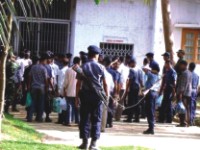 |
| BDR men being detained in Bandarban. |
According to internationally accepted operating procedure in a standoff, a professional negotiator must immediately establish contact with the hostage takers. Did the did police, the army or the home ministry have such a negotiator? If there is evidence of bloodshed, the negotiator must ask for “proof of life” i.e., he must ask the hostage takers about the condition of the hostages, and if possible ask to speak to the hostages. Was this procedure followed in the case of the Pilkhana incident? For two days, there was no official word on the condition of DG BDR and other missing officers, although sections of the Indian media reported the DG had been killed along with his wife. The probe committee, although critical of the media's role, did not address these issues.
Analysts have also questioned the wisdom of taking mutineers directly to the Prime Minister in an uncertain situation. It is worth noting that some of the mutineers were masked, while a few exposed their faces. DAD Tawhid, later arrested as one of the masterminds, was confident enough to speak to the media on camera. But to this day, the identity of all of the 14 men is not known.
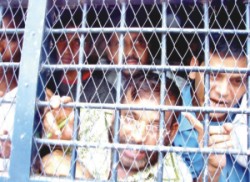 |
| 43 BDR men being sent to Jessore Jail. |
The probe report mentions that a large number of mutineers escaped via the 5th Gate and by scaling the wall along the Hazaribagh and Lalbagh areas. They took arms and ammunition with them. BDR men could be seen on TV melting into the crowd assembled outside. The inquiry does not address the appalling failure of the security cordon, and those responsible for this breach. The committee claims BNP leader Nasiruddin Pintu provided boats for the escaping Jawans, but makes no mention of Awami League leader Torab Ali, his son criminal Leather Liton and former BDR member Kanchan's son Zakir who were allegedly implicated in a separate inquiry carried out by the army.
The members of the army showed admirable discipline in an extremely volatile situation. But the question must be asked, do our security forces not have rapid strike units a la the SWAT teams in the West? The army does have a commando unit, but it is based in Sylhet, far removed from the capital.
It is crystal clear that the Pilkhana carnage was a carefully planned and boldly executed operation aimed at striking at the very heart of Bangladesh's national security. The perpetrators had a well-defined mission and an obvious exit strategy. It is in our national interest that the real facts behind the brutal murder of 57 army officers are unearthed. After 90 days of waiting for the Anisuzzaman Khan probe, we are no closer to learning the truth.
Copyright
(R) thedailystar.net 2009 |
